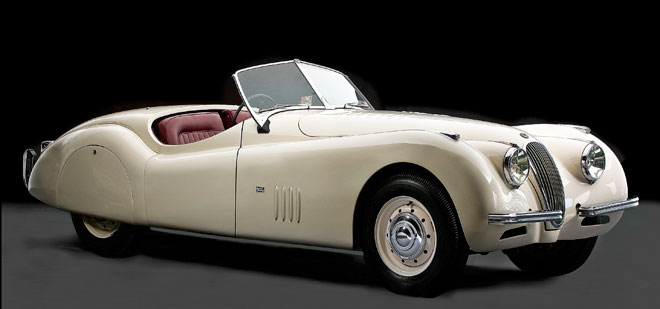SCM Analysis
Detailing
| Vehicle: | 1949 Jaguar XK 120 alloy roadster |
| Years Produced: | Alloy body 1949-1950; standard body 1951-1954 |
| Number Produced: | Alloy body: 240; standard body: 7,391 |
| Original List Price: | Alloy body: $4,020 (1948); standard body: $3,350 (1951) |
| SCM Valuation: | $185,000-$285,000 |
| Tune Up Cost: | $650 |
| Chassis Number Location: | Data plate on firewall |
| Engine Number Location: | Right side of engine block |
| Club Info: | Jaguar Clubs of North America, c/o Deannie Kennedy, 5196 Youngfield Court, Arvada, CO 80002 |
| Website: | http://www.jcna.com |
| Alternatives: | 1953-63 AC Ace Roadster, 1950-53 Aston Martin DB2 DHC |
This car, Lot 263, sold for $246,966, including buyer’s premium, at Bonhams’ Sydney, AUS, auction on November 13, 2010.
Provenance is a wonderful word, as pleasant to say as it is important to consider in classic car valuations. Normally, it is simply proof that the previous owners of the automobile are all known, so there is no question of the car’s ownership and identity.
In the case of 660017, provenance may be the most important aspect of this car. This isn’t so much because it affects the value of the car—the price paid was squarely in the middle of the value range. It isn’t even so much that the provenance justifies the modifications on this car, including those non-standard louvers in the bonnet and wings, and the non-standard performance parts on the engine.
No, in the case of this lovely, cream-colored XK120, the car’s provenance encapsulates in tangible form significant aspects of the development and use of high-performance automobiles in Australia.
We can think, of course, about the significance of the few alloy-bodied XK120s, which were essentially prototypes intended to garner desperately needed foreign currency that Jaguar used to fund development of its mainstream automobiles in the war-deprived economy of England in 1949 and 1950.
But this is a right-hand-drive alloy-bodied car, one of only 54 RHD models built, as the XK120 was not intended to be sold in the United Kingdom. Instead, this car was shipped to Australia, a small but fertile market for high-performance cars. The car would remain in Australia through its entire first lifetime, and it would be actively and aggressively used in competition.
Modifications add to provenance
Even the modifications tell their own story. The head and carburetors were from one of the fabled Jaguar C-types, but not just any C-type. They were taken from the C-type of Frank Gardner, who is a folk hero in Australian motorsports, which indicates that this car was in the thick of the fray at the peak of its competitive life.
Finally, this XK120 might be considered a monument of sorts to its last pilot, the Hon. John Dawson-Damer, who is most well-known for his leadership in the Australian historic motorsports movement, chairman of the Confederation of Australian Motor Sport and a member of the historic section of the FIA.
Although Dawson-Damer’s name may not be known to many people outside Australia, thousands of people who attend the Goodwood Festival of Speed will remember his tragic death in 2000, one of only two deaths that have ever happened during the Festival. Right at the finish of the hill climb, Dawson-Damer lost control of his four-wheel-drive Lotus 63 and crashed into the finish line gantry, killing himself and one of the marshals.
Sometimes an historic automobile represents only an opportunity for further use by providing its owners with access to acclaimed events. In this case, XK120 660017 is an important artifact of Australian motorsports and we hope that it will continue to be used publicly—but carefully—in a manner appropriate to the memories wrapped up in its alloy panels.
This was a fine deal for both the buyer and the seller, as the former got a properly-sized bundle of cash, and the latter a fully-documented, usable piece of motoring history.
